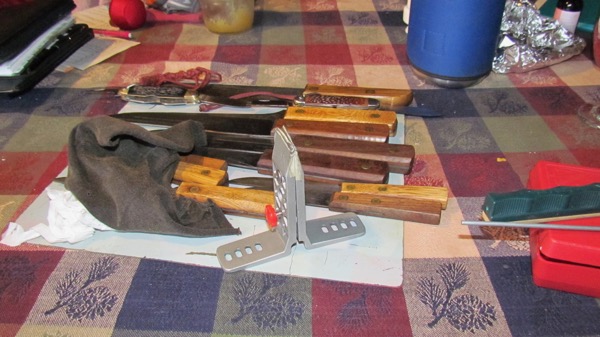About once a year, I pull out my knife sharpening kit to sharpen the kitchen knives. This year, I managed to do it in January, rather than March, when I generally get around to it.
My main task, in a sharpening session, is to sharpen the kitchen knives, primarily our carbon steel “Old Hickory” set (see High Carbon Steel Kitchen Knives) although I generally pick up a few other blades, like our pocket knives. If I’m going to make a big production, I may as well go all out.
Before I continue, I must stress: many knife sharpening systems exist, and there are many ways to sharpen knife blades. I am not advocating my method, or implying it is in any way superior to other methods. It’s merely the method I use.
Back when I acquired our kitchen knives, I researched various sharpening systems, and settled on the Lansky Deluxe 5-Stone Sharpening system (paid link) It got good ratings, and fell in my price range. I use it for “formal” sharpening, my once-a-year sharpening session. In between times, I use various methods for touching up the edges of our knives, from a diamond-dust wand to a chef’s sharpening steel to actual whet stones of various makes and sizes.
The reason I like the Lansky is that it allows consistent whetting angles from 17-30°, so I can shape a keen, consistent edge without a lot of concentration. My biggest problem with hand sharpening a blade comes from finding and holding the constant angle for whetting (I like 20-25° personally) throughout the sharpening process. The Lansky system frees me from that problem. The sharpening jig includes all of the main angles, with easy-to-understand instructions, and good guides.
Most of my sharpening sessions include only the medium and fine stones or bars. I use the coarser bars to repair blades when needed (see How to Repair a Damaged Ax Blade); I occasionally use the ultra fine bar for really bright work.
Part of the sharpening process also includes wiping the blades and the wooden handles with a mineral oil-soaked rag. We keep one hanging on a nail near the kitchen sink, ready to touch up the knives through the year on a whim. We use the edible mineral oil, sometimes used as baby laxative, because the knives are used for food preparation.
We find that most of the high carbon steel edges hold for most of a year. Making a thorough, annual project of it works pretty well for us.


